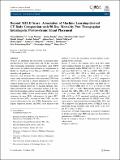Beyond MELD Score: Association of Machine Learning-derived CT Body Composition with 90-Day Mortality Post Transjugular Intrahepatic Portosystemic Shunt Placement
Author(s)
Elhakim, Tarig; Mansur, Arian; Kondo, Jordan; Omar, Omar M. F.; Ahmed, Khalid; Tabari, Azadeh; Brea, Allison; Ndakwah, Gabriel; Iqbal, Shams; Allegretti, Andrew S.; Fintelmann, Florian J.; Wehrenberg-Klee, Eric; Bridge, Christopher; Daye, Dania; ... Show more Show less
Download270_2024_Article_3886.pdf (1.448Mb)
Publisher with Creative Commons License
Publisher with Creative Commons License
Creative Commons Attribution
Terms of use
Metadata
Show full item recordAbstract
Purpose To determine the association of machine learning-derived CT body composition and 90-day mortality after transjugular intrahepatic portosystemic shunt (TIPS) and to assess its predictive performance as a complement to Model for End-Stage Liver Disease (MELD) score for mortality risk prediction. Materials and Methods This retrospective multi-center cohort study included patients who underwent TIPS from 1995 to 2018 and had a contrast-enhanced CT abdomen within 9 months prior to TIPS and at least 90 days of post-procedural clinical follow-up. A machine learning algorithm extracted CT body composition metrics at L3 vertebral level including skeletal muscle area (SMA), skeletal muscle index (SMI), skeletal muscle density (SMD), subcutaneous fat area (SFA), subcutaneous fat index (SFI), visceral fat area (VFA), visceral fat index (VFI), and visceral-to-subcutaneous fat ratio (VSR). Independent t-tests, logistic regression models, and ROC curve analysis were utilized to assess the association of those metrics in predicting 90-day mortality. Results A total of 122 patients (58 ± 11.8, 68% male) were included. Patients who died within 90 days of TIPS had significantly higher MELD (18.9 vs. 11.9, p < 0.001) and lower SMA (123 vs. 144.5, p = 0.002), SMI (43.7 vs. 50.5, p = 0.03), SFA (122.4 vs. 190.8, p = 0.009), SFI (44.2 vs. 66.7, p = 0.04), VFA (105.5 vs. 171.2, p = 0.003), and VFI (35.7 vs. 57.5, p = 0.02) compared to those who survived past 90 days. There were no significant associations between 90-day mortality and BMI (26 vs. 27.1, p = 0.63), SMD (30.1 vs. 31.7, p = 0.44), or VSR (0.97 vs. 1.03, p = 0.66). Multivariable logistic regression showed that SMA (OR = 0.97, p < 0.01), SMI (OR = 0.94, p = 0.03), SFA (OR = 0.99, p = 0.01), and VFA (OR = 0.99, p = 0.02) remained significant predictors of 90-day mortality when adjusted for MELD score. ROC curve analysis demonstrated that including SMA, SFA, and VFA improves the predictive power of MELD score in predicting 90-day mortality after TIPS (AUC, 0.84; 95% CI: 0.77, 0.91; p = 0.02). Conclusion CT body composition is positively predictive of 90-day mortality after TIPS and improves the predictive performance of MELD score. Level of Evidence: Level 3, Retrospective multi-center cohort study. Graphical Abstract
Date issued
2024-10-29Department
Massachusetts Institute of Technology. Department of Biological EngineeringJournal
CardioVascular and Interventional Radiology
Publisher
Springer US
Citation
Elhakim, T., Mansur, A., Kondo, J. et al. Beyond MELD Score: Association of Machine Learning-derived CT Body Composition with 90-Day Mortality Post Transjugular Intrahepatic Portosystemic Shunt Placement. Cardiovasc Intervent Radiol (2024).
Version: Final published version